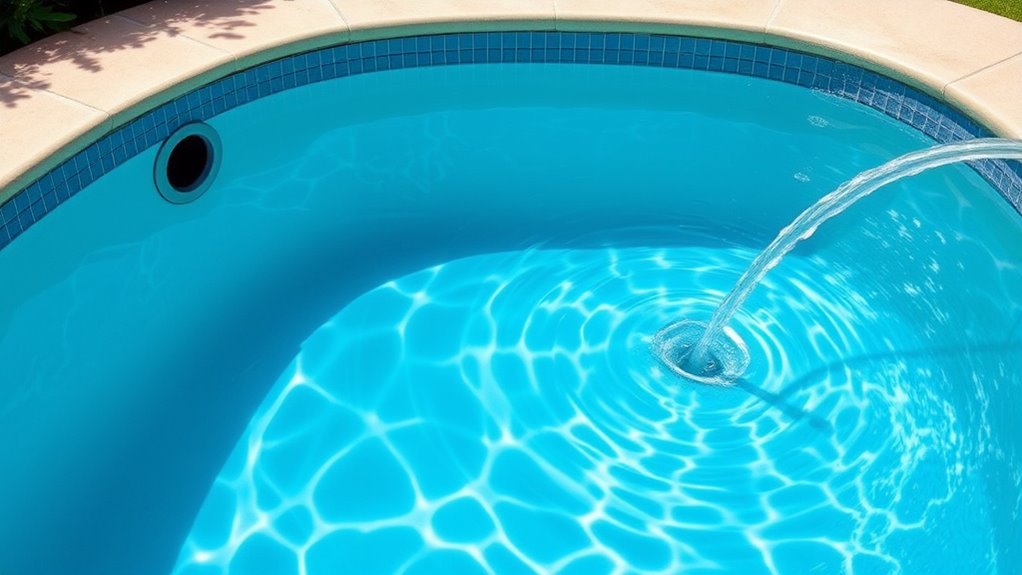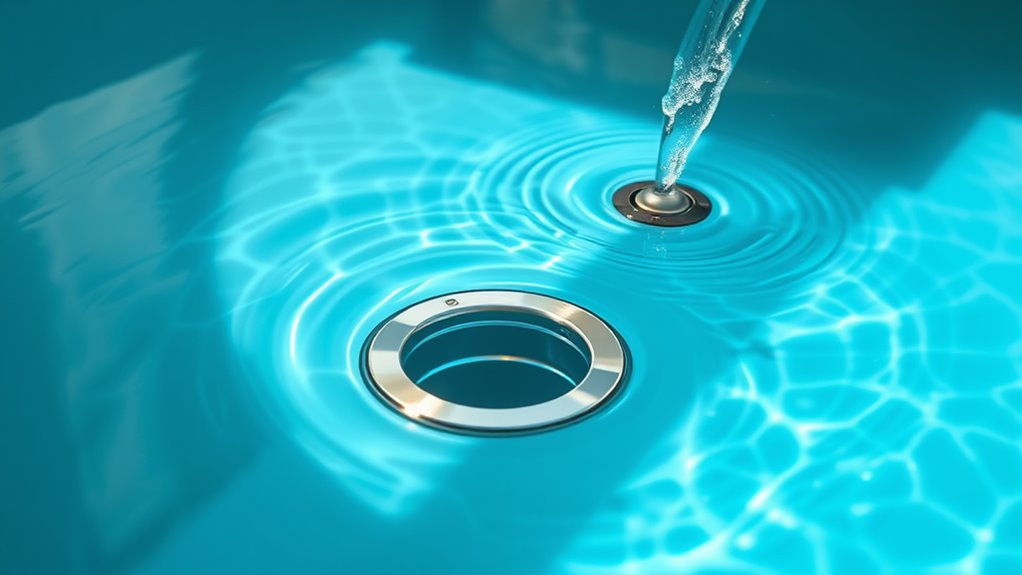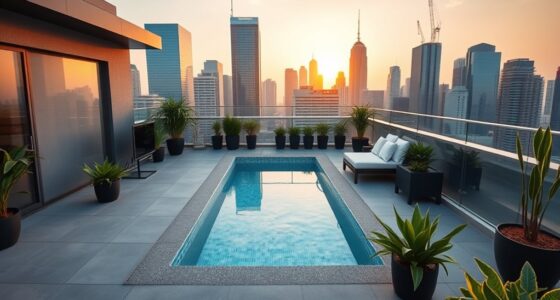To optimize circulation in your small pool, place the skimmer near the surface where debris gathers, ideally on the windward side, so it captures leaves and bugs efficiently. Position the returns opposite or diagonally from the skimmer to promote even water movement and prevent stagnation. Adjust their angles to support a smooth circular flow, helping debris move toward the skimmer while maintaining clarity. Keep exploring to discover more tips for a sparkling, well-balanced pool.
Key Takeaways
- Place the skimmer near the water surface on the windward side to effectively catch floating debris.
- Position returns opposite or diagonally from the skimmer to promote proper water circulation.
- Mount the skimmer at a height that captures debris without pulling in air or creating turbulence.
- Angle return jets to encourage circular flow, avoiding dead spots and stagnation.
- Ensure proper spacing between skimmer and return to prevent short-circuiting and maximize filtration efficiency.

Proper placement of skimmers and returns is essential for keeping your small pool clean and balanced. When you position these components correctly, you ensure ideal water circulation, which directly impacts how well debris is collected and how evenly the water temperature and chemicals are distributed. Good water circulation prevents stagnant spots, minimizes algae growth, and enhances the efficiency of your pool’s filtration system. Without proper placement, debris can accumulate in certain areas, making your cleaning chores more difficult and potentially damaging your pool equipment over time.
Proper skimmer and return placement ensures optimal water circulation and keeps your small pool clean and balanced.
Start by positioning the skimmer at a point where it can effectively draw in surface debris. For small pools, this usually means placing the skimmer near the surface where leaves, bugs, and other floating debris tend to gather. If your pool has a prevailing wind direction, position the skimmer on the windward side to maximize debris collection. This placement ensures that floating debris is drawn directly into the skimmer basket, reducing the likelihood of debris sinking to the bottom or clogging your pool’s pump or filter system. Keep in mind that the skimmer should be mounted at a height that allows it to capture surface debris efficiently without pulling in air or allowing water to bypass the skimmer opening.
Next, consider the placement of the returns, which introduce cleaned water back into the pool. Ideally, you want the returns to be positioned opposite or diagonally from the skimmer. This setup promotes water circulation across the entire pool surface, encouraging debris to move toward the skimmer naturally. Proper return placement also helps distribute heated or chemically treated water evenly, maintaining a consistent and comfortable swimming environment. When installing the returns, aim them towards the pool’s center to create a gentle circular flow, avoiding dead spots where water might stagnate. Additionally, ensuring the use of high-quality pool circulation components can improve overall water flow and debris removal efficiency.
Balancing the placement of skimmers and returns is key to maintaining water clarity and quality. If the returns are too close together or too close to the skimmer, you might create short-circuiting, where water circulates in a limited area and doesn’t flow throughout the entire pool. This hampers debris collection and can lead to uneven chemical distribution. Adjusting the angles and positions of the returns can improve water flow, helping debris move toward the skimmer more effectively and ensuring your pool remains clean and well-balanced.
Ultimately, paying close attention to skimmer and return placement maximizes water circulation, making debris collection more efficient and keeping your small pool sparkling clean. Proper positioning ensures that circulation patterns support your pool’s filtration and sanitation efforts, saving you time and effort in maintenance while providing a healthier swimming environment.
Frequently Asked Questions
How Often Should I Adjust Skimmer and Return Positions?
You should modify skimmer and return positions whenever you notice changes in pool pressure or circulation efficiency. Regularly check your pool’s flow and look for uneven water movement or debris buildup. Adjustments may be needed weekly or after heavy use, storms, or debris. Keeping an eye on these factors helps maintain proper circulation, prevents algae growth, and guarantees your pool stays clean and clear with ideal skimmer and return placement.
Can Placement Affect Pool Water Clarity?
Think of your pool’s water like a well-choreographed dance; proper skimmer and return placement keeps the rhythm smooth. Yes, placement affects water clarity by optimizing water circulation and debris removal, preventing stagnation and debris buildup. When you position skimmers and returns correctly, you ensure the water flows evenly, trapping dirt before it clouds the pool. Adjust placements as needed to maintain crystal-clear water, making your pool inviting and pristine.
What Are Signs of Poor Skimmer or Return Placement?
If your pool shows signs of poor skimmer or return placement, you might notice skimmer blockage, where debris clogs the skimmer, reducing its efficiency. Return turbulence, such as strong jets or uneven water flow, indicates improper placement, causing poor circulation and potential water clarity issues. These signs suggest you need to reposition the skimmer or returns for better water flow, cleaner water, and more effective filtration.
Is Professional Installation Recommended for Optimal Placement?
Yes, professional installation is highly recommended for ideal placement of skimmers and returns. You’ll benefit from expert advice and adherence to installation guidelines, ensuring your pool functions efficiently and minimizes issues like poor circulation or debris buildup. Professionals have the experience to position skimmers and returns correctly, which helps keep your pool clean and balanced. Investing in expert installation ultimately saves you time, effort, and potential costly repairs down the line.
How Does Pool Shape Influence Skimmer and Return Positioning?
Your pool shape greatly influences skimmer placement. For rectangular pools, position the skimmer on the longer side to maximize debris collection, while in freeform shapes, place it where debris naturally gathers. Return placement should promote even water circulation, often opposite the skimmer. Proper positioning ensures cleaner water and efficient filtration, so consider the pool’s specific shape when planning skimmer and return locations for ideal performance.
Conclusion
Proper skimmer and return placement in small pools ensures ideal water circulation and cleanliness. Did you know that poorly placed skimmers can remove up to 30% less debris? By positioning your skimmer and return correctly, you enhance filtration efficiency and keep your pool sparkling. Don’t overlook these small details—they make a big difference in maintaining a pristine, inviting pool all season long. Take the time to get your placements right, and you’ll enjoy clearer water with less hassle.








